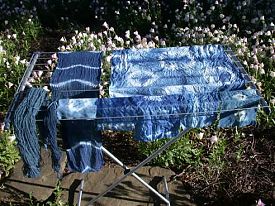29 May 11
Indigoing
 I attended a workshop in Berkeley yesterday put on by the Spindles and Flyers group (lovely to see Lisa there). It was an indigo dyeing workshop using greener chemicals. This doesn’t mean we fermented a pot of indigo for ten days in urine, which is also a green method; we used slake lime, iron phosphate, and indigo. (The more toxic combinations from the nineteenth century involved sodium hydrosulphite and zinc-lime formulas.)
I attended a workshop in Berkeley yesterday put on by the Spindles and Flyers group (lovely to see Lisa there). It was an indigo dyeing workshop using greener chemicals. This doesn’t mean we fermented a pot of indigo for ten days in urine, which is also a green method; we used slake lime, iron phosphate, and indigo. (The more toxic combinations from the nineteenth century involved sodium hydrosulphite and zinc-lime formulas.)
Barbara Shapiro encouraged us to bring personal projects to dye (I brought some Jacob handspun, woolen spun three plies; it’s at the lower left in the photo). She gave us samples to try different shibori resist techniques on — cotton, linen, rayon, silk, and wool. The same exact exposure to the dyebath produces very different results depending on the material being dyed. Wool produces a sort of Prussian blue, “sad” blue as Barbara called it. Silk doesn’t take the dye so strongly and leaves sections that are more yellow, making the whole look like a cyanotype. Rayon takes the dye very quickly and strongly. Cotton and linen make a beautiful deep blue. We learned that Japanese master dyers sometimes do 18 dippings to get a rich, deep blue. (The only piece I dipped more than once is the scarf at the upper left; it was dipped twice. Now that it’s dry it’s much lighter than in the photo. I can see dipping 5 or 6 times. The caustic solution is not good for wool so I wouldn’t want to do more than 3 or 4 for wool, though.)
Oxidation is what makes this work — the fabric is green in the dye bath and on contact with air almost immediately turns blue. It’s magical. We were all sent home with residual dye from the class and I have some plans for some undyed merino-silk.
